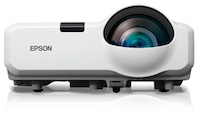Epson To Ship Interactive Projector Module Plus New Short-Throw Classroom Projectors

The PowerLite 400-series offers wired LAN connectivity and compatibility with the forthcoming BrightLink Solo 3 interactive module. |
Epson has debuted four new short-throw LCD classroom projectors and is gearing up to release a new standalone module that turns those projectors into interactive display devices.
The new interactive module, the BrightLink Solo 3, is designed specifically for four new projectors Epson is adding to its PowerLite 400 series. Those include the PowerLite 420, 425W, 430, and 435W.
The PowerLite 420 is an entry-level short-throw projector offering a resolution of 1,024 x 768 (XGA), a contrast ratio of 3,000:1, and a brightness of 2,500 lumens. With a throw ratio of 0.54 to 0.74, the projector can produce an image up to 106 inches (diagonal) from about 46 inches.
The PowerLite 425W is a widescreen (16:10) version of the 420, with the same contrast ratio and brightness, but offering a WXGA resolution (1,280 x 800). It offers a throw ratio of 0.48 to 0.65 to project a 113-inch (diagonal) image from about 48 inches.
The PowerLite 430 is an XGA projector offering 3,000 lumens of brightness, a 3,000:1 contrast ratio, and a throw ratio of 0.54 to 0.74 to produce an image up to 106 inches (diagonal) from about 46 inches.
Finally, the PowerLite 435W is a widescreen (16:10) version of the PowerLite 430, with the same contrast ratio and brightness, but offering a WXGA resolution. Like the PowerLite 425W, it offers a throw ratio of 0.48 to 0.65 to project a 113-inch (diagonal) image from about 48 inches.
Other features common to all of the forthcoming PowerLite 400-series projectors include:
- Wired LAN connectivity with a wireless (802.11b/g/n) option;
- Manual vertical and horizontal keystone correction of ±15 degrees;
- Lamp life of up to 6,000 hours in economy mode; and
- Security features ranging from a Kensington-style lock port and padlock/cable hole to keyed password protection.
The new models measure 13.6" (w) x 11.7" (d) x 6.2" (h), including feet, and weigh in at 8.7 pounds.
AV inputs on all of the new models include HDMI, dual RGB (mini D-sub 15-pin), USB type B for display and audio, S-video, composite video, stereo RCA, dual stereo minijack, and microphone. AV outputs include RGB (mini D-sub 15-pin) and stereo minijack. Networking and control ports include LAN (RJ-45), USB types A and B, and RS-232C. A wireless 802.11b/g/n module is available as an option.
All of the new models will be compatible with the BrightLink Solo 3 using the short-throw projector mount or ceiling mount attachment. A version of the BrightLink Solo 3 will also be available with RM Easiteach software.
The BrightLink Solo 3 is expected to be available in December. It will sell for $499. Epson hasn't announced pricing on the RM Easiteach version, but RM Easiteach is a $100 addon for the current BrightLink Solo.
All four of the new projectors are expected to ship in November. The PowerLite 420 will sell for $949, the 425W for $1,049, the 430 for $1,049, and the 435W for $1,149.
Additional details can be found on Epson's projector portal or its Brighter Futures education site.